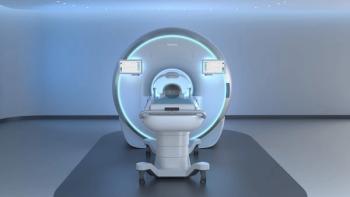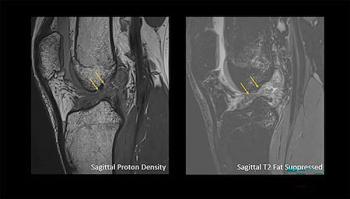
Whole-body staging with MRI, PET/CT can miss many melanoma metastases
In a surprising discovery, researchers from Germany have found that whole-body staging of patients with recently diagnosed malignant melanoma using either MRI or PET/CT could miss a substantial number of metastatic lesions.
Bone metastasis in 43-year-old patient with NSCLC detected with whole-body MRI and whole-body FDG-PET/CT. (Provided by G. Antoch and F. Vogt)
In a surprising discovery, researchers from Germany have found that whole-body staging of patients with recently diagnosed malignant melanoma using either MRI or PET/CT could miss a substantial number of metastatic lesions.
More than 50,000 U.S. patients will be diagnosed each year with melanoma, according to the National Cancer Institute. The disease is usually confined within a skin lesion but can spread through the body during advanced stages. Good prognosis depends on accurate tumor staging, which is done with CT, MRI, ultrasound, or scintigraphy. The whole-body exam has recently been recognized as the most accurate for staging. Radiologists must be aware, however, that regional or lymph node metastases could appear within a few months of the resection of a melanoma, and they cannot trust blindly in the primary imaging performed immediately after surgery, said Dr. Florian Vogt from the department of diagnostic and interventional radiology at the University Hospital of Essen. "You should always scan these patients at least a couple of times within one year of the primary staging. There might be future metastases, so these patients need long-term follow-up," Vogt said in an interview with
Diagnostic Imaging.
Vogt and colleagues enrolled 60 consecutive patients who underwent whole-body 1.5T MRI and whole-body FDG-PET/CT for staging of regional lymph nodes (N) and distant (M) metastases after primary tumor resection. The investigators followed the American Joint Committee on Cancer Staging guidelines for tumor classification and used biopsy and clinical follow-up as gold standards. Two radiologists interpreted MR images, while PET/CT scans were read by one radiologist and one nuclear physician. Fifty-six patients completed the mean follow-up of 748 days. The researchers found that a significant number of patients initially staged as N-negative and M-negative with whole-body MRI and whole-body PET/CT eventually proved to have undetected regional or distant metastases. Whole-body MRI and whole-body PET/CT determined regional lymph node involvement correctly in 46 and 48 cases, respectively. N-staging with whole-body MRI yielded a specificity of 100% but a sensitivity of only 23%. Regional lymph node staging with whole-body PET/CT fared only slightly better with specificity and sensitivity values of 100% and 38.5 %, respectively. The M-stage was diagnosed correctly in 42 patients with whole-body MRI and in 46 with PET/CT. Of 56 patients who underwent staging for distant metastases with PET/CT, three were confirmed as false positives and seven turned into false negatives (sensitivity, 41.7 % and specificity, 93.2 %). With whole-body MRI, the M-stage yielded three false positives and 11 false negatives (sensitivity, 15.4% and specificity, 93 %). Another research team from Essen also evaluated the accuracy of whole-body FDG-PET/CT and whole-body MRI for staging and detection of bone metastases in patients with a recent diagnosis of melanoma and non-small cell lung cancer.Dr. Gerald Antoch and colleagues assessed 109 patients, 55 with melanoma and 54 with NSCLC. Patients underwent whole-body staging with contrast-enhanced FDG-PET/CT. Patients also underwent nonenhanced T1/T2 and contrast-enhanced T1-weighted whole-body MRI within a mean time interval of 0.6 days of a PET/CT scan. A nuclear medicine physician and a radiologist read PET/CT and MRI studies, respectively, in a blinded fashion. Researchers also used histopathology and clinical follow-up (mean = 434 days) as the standards of reference. The investigators found whole-body PET/CT and whole-body MRI similarly accurate for staging and detection of bone metastases. They also observed a significant rate of false negatives, however, particularly with whole-body MRI, although the difference was not statistically significant when compared with whole-body PET/CT, Antoch said."There is a substantial number of false-negative findings if you perform the two imaging procedures at diagnosis of the patient. That really requires a close follow-up of these patients," Antoch said.The papers require validation by larger population studies, investigators said.
Newsletter
Stay at the forefront of radiology with the Diagnostic Imaging newsletter, delivering the latest news, clinical insights, and imaging advancements for today’s radiologists.




























